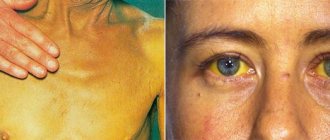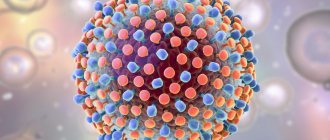About hepatitis C
The methods of infection with hepatitis C and its pathogenesis (mechanism of development) do not depend on the genotype. A viral infection enters the body hematogenously, through the blood. The entry point for the virus is often damage to the skin and mucous membranes during medical and cosmetic interventions.
Microtraumas of the genitals received during sexual intercourse can even act as an entrance gate. Moreover, the virus is present not only in the blood, but also in semen and vaginal secretions. Through sexual contact, infection is possible, but not necessary. But if there is a virus in donor blood, infection is inevitable.
But now this method is unlikely - all blood is tested for HCV. But using syringes contaminated with someone else’s blood is a typical way for drug addicts to become infected with hepatitis C and HIV. Therefore, in this category, both diseases are often combined.
Once in the body, the virus penetrates the liver, or more precisely, the hepatocytes, the cells that make up the functional liver tissue. By damaging the hepatocyte membrane, HCV penetrates and multiplies. It uses cellular resources to reproduce. In this case, several dozen new viral particles (virions) are formed inside the hepatocyte, and ultimately it dies.
And the daughter virions then look for a new hepatocyte and find it. Despite the apparent speed, the process develops gradually. The incubation period is long and can reach 6 months. Symptoms of jaundice, dark colored urine, and pain in the right hypochondrium characteristic of hepatitis are rarely observed.
Mostly, patients complain of general weakness, muscle pain, and a moderate increase in body temperature. All this is interpreted as fatigue or a cold. And for many, the disease is latent, asymptomatic, and quickly becomes chronic.
Symptoms in the form of liver disorders appear years later when the structure of the liver has changed. In later stages, the disease is complicated by cirrhosis with liver failure. A more rare complication is liver cancer, hepatocellular carcinoma.
This slow but steady development of the disease is due to the fact that the immune system still fights the virus, and some of the virions are destroyed. But the immune system is able to finally cope with HCV in no more than 15% of cases, when spontaneous recovery occurs. Treatment is also often ineffective - drugs that are effective for other hepatitis do not work on HCV.
This resistance of the virus to immune defenses and to the effects of drugs is largely due to its genetic variability. The genotype of the hepatitis C virus often changes under the influence of external and internal factors.
Why is it necessary to find out the genotype of hepatitis C?
Different genotypes of the virus react differently to the same drug. Identification of the hepatitis C virus (HCV) genotype is necessary in order to determine the following points:
- choice of drugs;
- duration of treatment;
- how effective the therapy will be;
- calculation of the dose of antiviral drugs;
- the likelihood of developing extrahepatic manifestations of the disease.
Today medicine knows 6 genotypes of the virus and many subtypes. Each of them has characteristic behavior.
| Genotype | Properties |
| Genotype 1 | It is difficult to treat, mutates easily, is considered the most dangerous, and often causes complications. |
| Genotype 2 | The first genotype is less common. The disease is characterized by a low viral load. The inflammatory process develops slowly. Complications are rare, and recovery is predicted in 90% of cases. |
| Genotype 3 | One of the most studied types. It responds well to treatment. The prognosis is favorable in 80% of cases. Without therapy, it can cause dangerous complications, such as liver fibrosis and steatosis. |
| Genotypes 4, 5, 6 | Little-studied types. There is no specific treatment regimen, therefore, when such genotypes are detected, therapy with traditional antiviral drugs (Interferon and Ribavirin) in combination with Sofosbuvir, Daclatasvir is used. |
According to WHO, about 300 million people are infected with the hepatitis C virus. It is expected that in the next couple of decades, chronic hepatitis C will become a major medical problem in many countries around the world.
Types and quasi-types of hepatitis C
One of the features of the hepatitis C virus is that it contains RNA. Genetic information in multicellular and unicellular organisms is encoded in the DNA of nuclear chromosomes. But the virus has a non-cellular structure. As for HCV, the genetic information is encoded in a single RNA enclosed in the capsid, the viral capsule. The long RNA chain of the virus contains more than 9 thousand units, nucleotides. The sequence of nucleotides determines the set of genes. And genes, in turn, ensure the synthesis of structural and non-structural proteins. Structural proteins, as the name suggests, are part of the structure of the virus - they make up the virion. And non-structural proteins provide various phases of the life of the virus, incl. its penetration into hepatocytes, replication, RNA copying, and the formation of new virions.
If you rearrange at least some of the nucleotides in the RNA chain, the genotype will change. And if the genotype changes, the properties of the synthesized proteins will change. Consequently, the properties of the virus itself will change. At the same time, hepatitis itself will change - it will be easier or more severe, with more or less resistance to the effects of drugs. Therefore, it is important to know which genotype responds best to treatment.
To date, 11 genotypes of the virus are known. But, apparently, there are more of them. According to the conclusions of WHO experts, out of 11 genotypes, 6 are relevant in terms of the incidence of hepatitis in different countries of the world.
It should be noted that the genotypes are also heterogeneous. Within each of them there are genetic differences. In this regard, subtypes are distinguished (syn. - subtypes, quasitypes). The number of quasitypes in each genotype varies from one to several dozen. In total, there are more than a hundred subtypes with different properties. Genotypes are usually designated by Roman or Arabic numerals, and quasitypes by lowercase Latin letters. For example, genotype 3a or 1b.
Hepatitis C: genotypes and their description
Viral hepatitis C is considered a serious disease - about 200 million people on Earth are infected with it, and it turns out to be fatal for 400 thousand of them per year. The danger of pathology is due to several factors:
- for many years the disease passes without pronounced symptoms (the so-called carriage);
- with untimely treatment, complications develop - cirrhosis and liver cancer (carcinoma);
- the hepatitis C virus is constantly mutating, which makes therapy difficult;
- The disease is often accompanied by HIV or hepatitis B, which quickly destroys the liver and other organs.
Constant mutations of the virus lead to the emergence of more and more new genotypes of hepatitis C. It is not known exactly how many of them exist: scientists identify 11, doctors diagnose 6 of the most common. In addition, within each genotype there are subtypes. The variety of genetic modifications of the virus makes it impossible to create a vaccine against this disease.
The types of hepatitis C genotypes are designated by numbers from 1 to 6. The number of subtypes differs in different types, they are called by Latin letters (a, b, c...). Viral hepatitis C 1 (HCV 1) has 3 subtypes (1a, 1b, 1c), HCV 2 has 4, and HCV 4 has 9.
A person may be diagnosed with mixed hepatitis. This is a phenomenon when more than one genotype is isolated.
To diagnose hepatitis, it is necessary to conduct a blood test for the presence of antibodies to HCV; genotypes are determined by polymerase chain reaction (PCR). PCR also detects the number of hepatitis viral particles (viral load) per milliliter of blood. The degree of liver damage depends on this.
1
Hepatitis C virus genotype 1 is found in all countries of the world more often than others. The most common subtype is 1b, which is characterized by a high percentage of chronicity (up to 80%). The risk of complications is high: a third of patients develop cirrhosis, 10% are diagnosed with liver cancer, and tumors of the lymphatic system are common. At the same time, hepatitis C genotype 1a gives more pronounced symptoms, which forces a person to go to the doctor and start treatment.
It is believed that people who have been transfused with untested donor blood are at greatest risk of contracting hepatitis C 1.
There are several stages:
- The acute phase, the duration of which is from 1 to 6 months. It is asymptomatic.
- Chronic, when hepatocytes are actively destroyed, pathologies of other organs develop. For several years the latent phase passes without clinical signs. If you violate your diet and exercise, heaviness or pain occurs in the right hypochondrium.
- Clinical stage characterized by irreversible changes in the liver, cirrhosis.
Hepatitis C 1 is difficult to treat; therapy is often carried out for more than 48 weeks. Its success depends on the level of viral load, the presence of concomitant pathologies, and adherence to diet.
2
Hepatitis C genotype 2 is rare; subtypes 2b and 2c are common in Europe. It responds well to treatment, and antiviral therapy lasts 24-48 weeks.
At the initial stage of the disease, there are no symptoms, but later signs characteristic of all types of pathology appear:
- constant fatigue;
- digestive disorders;
- elevated body temperature.
It is possible to diagnose the disease only in the active phase, when the level of AST and ALT, alkaline phosphatase in the blood increases, and antibodies to hepatitis C appear. The genotype is determined by PCR, and the viral load is simultaneously determined.
The virus can be transmitted in utero, through mother's milk, or through unprotected sexual intercourse. If treatment is carried out in a timely manner, up to 80% of patients recover, and the likelihood of developing cirrhosis or liver cancer is low. Exacerbations are possible in 10% of recovered patients.
With poor diet, alcohol intake, or a high viral load, other complications (arthritis, thyroid inflammation) characteristic of this genotype may develop.
3
Genotype 3 is diagnosed in the Russian Federation in 20% of patients with hepatitis C. In Europe, its subtypes 3a and 3b are found, which are detected mainly in people under 30 years of age with drug addiction and promiscuity.
The acute phase is usually asymptomatic. The chronic process is accompanied throughout the entire period by low-grade fever, pain in the liver, and dyspepsia.
Although hepatitis C 3 is treated better than others, it develops faster. If therapy is not prescribed on time, fatty and fibrous degeneration of liver tissue occurs, and in rare cases, carcinoma is diagnosed.
Treatment is complicated by the addition of HCV 3 to viruses of other genotypes. A positive result is achieved with the right treatment strategy, following a diet and avoiding alcoholic beverages.
4, 5, 6
These types of hepatitis C virus genotypes are not found in Russia and have been poorly studied. Their share in the world accounts for no more than 10-15% of all cases of hepatitis C.
Genotype C4 is represented by nine subtypes and is distributed in the Northern and Central regions of Africa. Treatment of chronic hepatitis C4 with antiviral drugs takes a long time - at least a year; repeated therapy with replacement of drugs is often required. Treatment is considered successful if liver test results are normal and the absence of viral particles during PCR persists for a long time (at least six months).
Genotype C5 is found in southern Africa, C6 is common in Thailand, Vietnam, and Japan. Like other types of hepatitis C, they are transmitted through blood during sterility violations during injections, tattooing, piercing, and also during unprotected sex.
Which genotypes are most common in Russia
Of the 6 HCV genotypes in Russia, the first 3 are most common. Of these, the most epidemiologically significant are: 1a and 1b, 2a, 2b, and 2c, 3a and 3b. These quasitypes cause hepatitis C not only in the Russian Federation, but also in other post-Soviet republics, as well as in the countries of Asia, Africa, Western Europe and North America. As for the other three genotypes, 4, 5, and 6, they are mainly distributed in the regions of Southeast Asia and the African continent. In Russia, hepatitis is rarely caused by these viruses, in approximately 1% of cases. But these genotypes should not be completely discounted. Population mobility is increasing around the world. The number of tourists, labor migrants, and refugees is increasing. Therefore, it is possible that the role of these genotypes in the incidence of hepatitis C in Russia will increase over time.
INTERPRETATION OF RESULTS:
Reference values:
are not indicated.
Depending on the identified HCV genotype, treatment tactics are determined.
We draw your attention to the fact that the interpretation of research results, diagnosis, as well as the prescription of treatment, in accordance with Federal Law No. 323-FZ “On the fundamentals of protecting the health of citizens in the Russian Federation” dated November 21, 2011, must be carried out by a doctor of the appropriate specialization.
" ["serv_cost"]=> string(4) "2190" ["cito_price"]=> NULL ["parent"]=> string(2) "25" [10]=> string(1) "1" [ "limit"]=> NULL ["bmats"]=> array(1) { [0]=> array(3) { ["cito"]=> string(1) "N" ["own_bmat"]=> string(2) “12” [“name”]=> string(22) “Blood with EDTA” } } }
Features of treatment of different genotypes
The most common genotype in Russia is genotype 1. It is also the heaviest, especially 1b. The disease begins latently and quickly becomes chronic. Despite the measures taken, hepatitis often recurs and ends in cirrhosis with liver failure. This genotype is characterized by a high probability of hepatocellular carcinoma. The chances of recovery are reduced because treatment of genotype 1b in many patients is delayed due to latency and late diagnosis.
Genotype 1a is also severe with liver complications, incl. and with the development of a malignant liver tumor. But here the disease, as a rule, passes through an acute initial stage. And if you seek help in time and carry out a diagnosis, then with genotype 1a, treatment will be more effective. Genotype 3 ranks second in frequency after genotype 1. The disease is found mainly in young people, and occurs with the early appearance of fibrosis and steatohepatosis (fatty degeneration) of the liver tissue. But if treatment for hepatitis C genotype 3 is timely and correct, complications will be avoided.
Which genotype is the most dangerous?
Genotype 1 is considered the most dangerous and is more difficult to treat than the others. Subtype 1B is the most unfavorable, since it is prone to transformation into a chronic form. This increases the risk of developing serious complications. Requires treatment with higher doses of antiviral and immunomodulatory drugs throughout the year.
The progression of the most dangerous genotype may be indicated by the following clinical picture:
- frequent complaints of pain in the right hypochondrium;
- bitterness in the mouth;
- general weakness and fatigue, including muscle fatigue;
- flatulence;
- stool discoloration;
- darkening of urine;
- increase in body temperature;
- yellowness of the skin, sclera of the eyes.
Symptoms are not always specific; to confirm the diagnosis, an in-person examination by a hepatologist and additional studies are required.
The prognosis for the most dangerous form of hepatitis C depends on how early the disorder is identified and appropriate treatment is prescribed. Drug treatment slows the progression of fibrosis and smoothes the clinical picture of the disease. There is a possibility of relapse of the disease.
Which genotype is easier to treat?
Genotype 2 is often called benign. The inflammatory process here is not as violent as with other hepatitis. The viral load is minimal. And complications rarely occur. Therefore, speaking about which genotype of hepatitis C is better treated, we can say with confidence – genotype 2.
Indeed, according to the observations of specialists, with timely and adequate treatment measures for hepatitis C genotype 2, the prognosis for recovery and life is favorable. However, without treatment, the disease, as with other genotypes, will result in complications. It should also be taken into account that the frequency of diseases with genotype 2 is relatively low. In addition, it is often combined with other genotypes.










